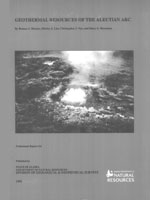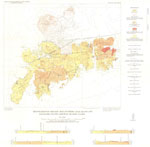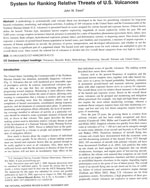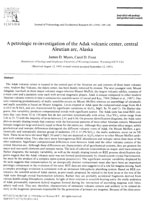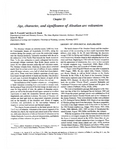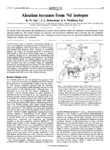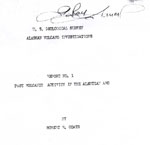References
Cameron, C.E., Crass, S.W., and AVO Staff, eds, 2022, Geologic database of information on volcanoes in Alaska (GeoDIVA): Alaska Division of Geologic and Geophysical Surveys Digital Data Series 20, https://doi.org/10.14509/geodiva, https://doi.org/10.14509/30901.
Kay, S.M., Jicha, B.R., Citron, G.L., Kay, R.W., Tibbets, A.K., and Rivera, T.A., 2019, The calc-alkaline Hidden Bay and Kagalaska plutons and the construction of the central Aleutian oceanic arc crust: Journal of Petrology v. 60, n. 2, p. 393-439, doi:10.1093/petrology/egy119, https://academic.oup.com/petrology/article/60/2/393/5258477
Ewert, J.W., Diefenbach, A.K., and Ramsey, D.W., 2018, 2018 update to the U.S. Geological Survey national volcanic threat assessment: U.S. Geological Survey Scientific Investigations Report 2018-5140, 40 p., https://pubs.usgs.gov/sir/2018/5140/sir20185140.pdf.
Jicha, B.R., and Kay, S.M., 2018, Quantifying arc migration and the role of forearc subduction erosion in the central Aleutians: Journal of Volcanology and Geothermal Research, v, 360, p. 84-99, doi: http://dx.doi.org/10.1016/j.jvolgeores.2018.06.016.
Cameron, C.E., and Snedigar, S.F., 2016, Alaska Volcano Observatory image database: Alaska Division of Geological & Geophysical Surveys Digital Data Series 13, https://www.avo.alaska.edu/images/. https://doi.org/10.14509/29689.
Yogodzinski, G.M., Brown, S.T., Kelemen, P.B., Vervoort, J.D., Portnyagin, Maxim, Sims, K.W.W., Hoernle, Kaj, Jicha, B.R., and Werner, Reinhard, 2015, The role of subducted basalt in the source of island arc magmas: evidence from seafloor lavas of the Western Aleutians: Journal of Petrology, v. 56, n. 3, p. 441-492, doi:10.1093/petrology/egv006
Buurman, Helena, Nye, C.J., West, M.E., and Cameron, Cheryl, 2014, Regional controls on volcano seismicity along the Aleutian Arc: Geochemistry, Geophysics, Geosystems, doi:10.1002/2013GC005101
Cameron, C.E., and Nye, C.J., 2014, Preliminary database of Quaternary vents in Alaska: Alaska Division of Geological & Geophysical Surveys Miscellaneous Publication 153, 11 p., doi:10.14509/27357 .
Krawiec, A.C.L, 2013, Holocene tephrochronology and storminess inferred from two lakes on Adak Island, Alaska: Northern Arizona University M.S. thesis, 109 p.
Krawiec, A.C., Kaufman, D.S., and Vaillencourt, D.A., 2013, Age models and tephrostratigraphy from two lakes on Adak Island, Alaska: Quaternary Geochronology, v. 18, p .41-53.
Mastin, L.G., Guffanti, Marianne, Ewert, J.E., and Spiegel, Jessica, 2009, Preliminary spreadsheet of eruption source parameters for volcanoes of the world: U.S. Geological Survey Open-File Report 2009-1133, v. 1.2, 25 p., available at http://pubs.usgs.gov/of/2009/1133/ .
Krutikov, Lena, Stone, David, and Minyuk, Pavel, 2008, New paleomagnetic data from the central Aleutian Arc: evidence and implications for block rotations: Geophysical Monograph, v. 179, p. 135-149, doi:10.1029/179GM07 .
Ewert, John, 2007, System for ranking relative threats of U.S. volcanoes: Natural Hazards Review, v. 8, n. 4, p. 112-124.
Yogodzinski, G.M., and Kelemen, P.B., 2007, Trace elements in clinopyroxenes from Aleutian xenoliths: implications for primitive subduction magmatism in an island arc: Earth and Planetary Science Letters, v.256, n. 3-4, p. 617-632.
Wilson, F.H., Mohadjer, Solmaz, Labay, K.A., Shew, Nora, and Grey, D.M., 2006, Digital data for the reconnaissance geologic map of the western Aleutian islands, Alaska: U.S. Geological Survey Open-File Report 2006-1302, 1 p., available online at http://pubs.usgs.gov/of/2006/1302/
Ewert, J.W., Guffanti, Marianne, and Murray, T.L., 2005, An assessment of volcanic threat and monitoring capabilities in the United States: framework for a National Volcano Early Warning System NVEWS: U.S. Geological Survey Open-File Report 2005-1164, 62 p.
Yogodzinski, Gene, and Kelemen, Peter, 2005, Mafic and ultramafic xenoliths from Kanaga and Adak Islands, central Aleutian Islands, Alaska [abs.]: in Abstracts of the 15th annual V.M. Goldschmidt conference, Geochemica et Cosmochemica Acta, v. 69, n. 10 (supplementary), p. 638.
Siebert, L., and Simkin, T., 2002-, Volcanoes of the world: an illustrated catalog of Holocene volcanoes and their eruptions: Smithsonian Institution, Global Volcanism Program Digital Information Series GVP-3, http://volcano.si.edu/search_volcano.cfm, unpaged internet resource.
Cameron, C. E., Triplehorn, J. H., and Robar, C. L., 2003, Bibliography of information on Alaska volcanoes: Alaska Division of Geological & Geophysical Surveys Miscellaneous Publication MP 131, 1 CD-ROM.
Hard Copy held by AVO at FBKS - CEC file cabinet
Kelemen, P.B., Yogodzinski, G.M., and Scholl, D.M., 2003, Along-strike variation in the Aleutian Island Arc: Genesis of high Mg# andesite and implications for continental crust, in Eiler, J., ed., Inside the Subduction Factory: AGU Monograph 138, p. 223-276.
O’Leary, M., 2001, Volcanic ash stratigraphy for Adak Island, central Aleutian archipelago, in Dumond, D.E. (ed.), Archaeology in the Aleut Zone of Alaska, University of Oregon Anthropological Papers, n. 58, p. 215-233.
Nye, C. J., Queen, Katherine, and McCarthy, A. M., 1998, Volcanoes of Alaska: Alaska Division of Geological & Geophysical Surveys Information Circular IC 0038, unpaged, 1 sheet, scale 1:4,000,000, available at http://www.dggs.dnr.state.ak.us/pubs/pubs?reqtype=citation&ID=7043 .
Hard Copy held by AVO at FBKS - CEC shelf
Kiriyanov, V. Y., and Miller, T. P., 1997, Volcanic ashes of Adak Island, Aleutian Islands, Alaska [Vulkanicheskiye peply na o-ve Adak (Aleutskiye o-va, SShA)]: Volcanology and Seismology [Vulkanologiya I Seysmologiya], v. 19, n. 1, p. 52-77.
Warner, R. D., and Wasilewski, P. J., 1997, Magnetic petrology of arc xenoliths from Japan and Aleutian Islands: Journal of Geophysical Research, v. 102, p. 20,225-20,243.
Yogodzinski, G. M., Kay, R. W., Volynets, O. N., Koloskov, A. V., and Kay, S. M., 1995, Magnesian andesite in the western Aleutian Komandorsky region: implications for slab melting and processes in the mantle wedge: Geological Society of America Bulletin, v. 107, n. 5, p. 505-519.
Waythomas, C. F., 1995, Surficial geologic map of northern Adak Island, Alaska: U.S. Geological Survey Open-File Report 95-0128, 6 p., 1 plate, scale 1:25,000.
Alaska Division of Geological & Geophysical Surveys, 1995, Volcanoes of Alaska: Alaska Division of Geological & Geophysical Surveys Information Circular IC 0038, unpaged, 1 sheet, scale 1:4,000,000.
Myers, J. D., and Frost, C. D., 1994, A petrologic re-investigation of the Adak volcanic center, central Aleutian arc, Alaska: Journal of Volcanology and Geothermal Research, v. 60, n. 2, p. 109-146.
Waythomas, C. F., 1994, New evidence for Holocene volcanic activity on northern Adak Island, Alaska [abs.]: Abstracts with Programs - Geological Society of America, v. 26, n. 7, p. A137-A138.
Kay, S. M., and Kay, R. W., 1994, Aleutian magmas in space and time: in Plafker, George and Berg, H. C., (eds.), The Geology of Alaska, Geological Society of America The Geology of North America series v. G-1, p. 687-722.
Hard Copy held by AVO at FBKS - CEC file cabinet
Myers, J. D., Nicolaysen, K. E., and Frost, C. D., 1994, Sr and Pb isotopic evidence for temporal and spatial controls on arc magmatic processes: new data from the central Aleutian Arc [abs.]: Abstracts with Programs - Geological Society of America, v. 26, n. 7, p. 368.
Waythomas, C. F., Miller, T. P., and Kiriyanov, V. Y., 1994, Post-glacial evolution of northern Adak Island, Alaska [abs.]: in American Quaternary Association, 13, Program and Abstracts, Minneapolis, MN, June 19-22, 1994, p. 179.
Vallier, T. L., Scholl, D. W., Fisher, M. A., Bruns, T. R., Wilson, F. H., von Huene, Roland, and Stevenson, A. J., 1994, Geologic framework of the Aleutian arc, Alaska: in Plafker, George and Berg, H. C., (eds.), The Geology of Alaska, Geological Society of America The Geology of North America series v. G-1, p. 367-388.
Hard Copy held by AVO at FBKS - CEC file cabinet
Simkin, Tom, and Siebert, Lee, 1994, Volcanoes of the world [2nd edition]: Tucson, Arizona, Geoscience Press, 349 p.
Hard Copy held by AVO at FBKS - CEC shelf
Miller, T. P., 1994, Geothermal resources of Alaska: in Plafker, George and Berg, H. C., (eds.), The Geology of Alaska, Geological Society of America The Geology of North America series v. G-1, p. 979-987.
Hard Copy held by AVO at FBKS - CEC file cabinet
Hard Copy held by AVO at FBKS - CEC shelf
Myers, J. D., 1994, The geology, geochemistry and petrology of the recent magmatic phase of the central and western Aleutian Arc: unpublished manuscript unpaged.
Hard Copy held by AVO at FBKS - CEC shelf
Fournelle, J. H., Marsh, B. D., and Myers, J. D., 1994, Age, character, and significance of Aleutian arc volcanism: in Plafker, George and Berg, H. C., (eds.), The Geology of Alaska, Geological Society of America The Geology of North America Series v. G-1, p. 723-758.
Bergsland, Knut, comp., 1994, Aleut dictionary, Unangam Tunudgusii, an unabridged lexicon of the Aleutian, Pribilof, and Commander Islands Aleut language: University of Alaska Fairbanks, Alaska Native Language Center, 739 p.
Motyka, R. J., Liss, S. A., Nye, C. J., and Moorman, M. A., 1993, Geothermal resources of the Aleutian Arc: Alaska Division of Geological & Geophysical Surveys Professional Report PR 0114, 17 p., 4 sheets, scale 1:1,000,000.
Hard Copy held by AVO at FBKS - CEC shelf
Waythomas, C. F., 1993, Geomorphic evidence of post-glacial uplift, northern Adak Island, Alaska: Eos, v. 74, n. 43, p. 233.
Kay, R. W., Kay, S. M., and Yogodzinski, G. M., 1992, Aleutian mantle-derived magmas and the mantle under the Aleutian Arc [abs.]: in International Geological Congress, 29, Abstracts, Kyoto, Japan, Aug. 24-Sept. 3, 1992, p. 555.
Romick, J. D., Kay, S. M., and Kay, R. W., 1992, The influence of amphibole fractionation on the evolution of calc-alkaline andesite and dacite tephra from the central Aleutians, Alaska: Contributions to Mineralogy and Petrology, v. 112, n. 1, p. 101-118.
Romick, J. D., 1990, Silicic volcanism and granulite xenoliths from the Aleutian Islands, Alaska: petrologic constraints for the evolution of the Aleutian Arc crust: Cornell University Ph.D. dissertation, 336 p.
Heusser, C. J., 1990, Late Quaternary vegetation of the Aleutian Islands, southwestern Alaska: Canadian Journal of Botany, v. 68, p. 1320-1326.
Perfit, M. R., Kay, S. M., Kay, R. W., and Citron, G. P., 1990, Calc-alkaline plutonism in the intra-oceanic Aleutian arc, Alaska [abs.]: in Kay, S. M. and Rarela, C. W., (ed.), Plutonism from Antarctica to Alaska, Geological Society of America Special Paper SPE 0241, Boulder, CO, Geological Society of America, p. 233-255.
Singer, B. S., and Myers, J. D., 1990, Intra-arc extension and magmatic evolution in the central Aleutian arc, Alaska: Geology, v. 18, n. 11, p. 1050-1053.
Yogodzinski, G. M., Kay, R. W., Volynets, O. N., Koloskov, A. V., and Seliverstov, N. I., 1990, Trace element diversity in isotopically MORB-like Aleutian magnesian andesites [abs.]: Eos, v. 71, n. 43, p. 1715.
Wood, C. A., and Kienle, Juergen, (eds.), 1990, Volcanoes of North America: United States and Canada: New York, Cambridge University Press, 354 p.
Hard Copy held by AVO at FBKS - CEC shelf
Myers, J. D., and Frost, C. D., 1989, Trace and rare earth element constraints on the origin and evolution of Aleutian arc magmas [abs.]: Eos, v. 70, n. 29, p. 721.
Kay, R. W., and Kay, S. M., 1989, Aleutian magmatic systems: an integrated view [abs.]: in Continental magmatism: abstracts, New Mexico Bureau of Mines and Mineral Resources Bulletin 0131, p. 148.
Hard Copy held by AVO at FBKS - CEC file cabinet
Hard Copy held by AVO at FBKS - CEC shelf
Singer, B. S., and Myers, J. D., 1989, Intra-arc extension and magmatic evolution in the central Aleutian Arc, Alaska [abs.]: Abstracts with Programs - Geological Society of America, v. 21, n. 6, p. A56.
Ryan, J.G., and Langmuir, C.H., 1988, Beryllium systematics in young volcanic rocks: implications for 10Be*: Geochimica et Cosmochimica Acta, v. 52, p. 237-244.
Plank, Terry, and Langmuir, C.H., 1988, An evaluation of the global variations in the major element chemistry of arc basalts: Earth and Planetary Science Letters, v. 90, p. 349-370.
Myers, J. D., and Marsh, B. D., 1987, Aleutian lead isotopic data: additional evidence for the evolution of lithospheric plumbing systems: Geochimica et Cosmochimica Acta, v. 51, n. 7, p. 1833-1842.
Hard Copy held by AVO at FBKS - CEC file cabinet
Kay, S. M., Kay, R. W., and Rubenstone, J. L., 1987, Geochemical evolution of magmatic rocks on Adak Island in the central Aleutian Island Arc, Alaska [abs.]: Eos, v. 68, n. 44, p. 1525.
Ryan, J.G., and Langmuir, C.H., 1987, The systematics of lithium abundances in young volcanic rocks: Geochimica et Cosmochimica Acta, v. 51, p. 1727-1741.
Kay, R. W., Rubenstone, J. L., and Kay, S. M., 1986, Aleutian terranes from Nd isotopes: Nature, v. 322, n. 6080, p. 605-609.
Hard Copy held by AVO at FBKS - CEC file cabinet
Kay, S. M., Kay, R. W., Romick, J. D., and Yogodzinski, G. M., 1986, Spacial variations in trace element ratios in the Aleutian Arc [abs.]: Abstracts with Programs - Geological Society of America, v. 18, n. 6, p. 651.
Luedke, R. G., and Smith, R. L., 1986, Map showing distribution, composition, and age of Late Cenozoic volcanic centers in Alaska: U.S. Geological Survey Miscellaneous Investigations Series Map I 1091-F, unpaged, 3 sheets, scale 1:1,000,000.
Goldstein, S.L., 1986, Isotopic studies of continental and marine sediments and igneous rocks of the Aleutian Island Arc: Columbia University Ph.D. dissertation, 357 p.
Hard Copy held by AVO at FBKS - CEC file cabinet
Myers, J. D., Marsh, B. D., and Sinha, A. K., 1985, Strontium isotopic and selected trace element variations between two Aleutian volcanic centers (Adak and Atka): implications for the development of arc plumbing systems: Contributions to Mineralogy and Petrology, v. 91, n. 3, p. 221-234.
Hard Copy held by AVO at FBKS - CEC file cabinet
Katzenstein, A. M., and Whelan, J. A., 1985, Geothermal potential of Adak Island, Alaska, NWC TP 6676: China Lake, CA, Naval Weapons Center, 92 p.
Myers, J. D., Marsh, B. D., and Sinha, A. K., 1984, Pb isotopic data from two Aleutian volcanic centers: additional evidence for the evolution of lithospheric plumbing systems [abs.]: Eos, v. 65, n. 45, p. 1135-1136.
Conrad, W. K., and Kay, R. W., 1984, Ultramafic and mafic inclusions from Adak Island: crystallization history, and implications for the nature of primary magmas and crustal evolution in the Aleutian Arc: Journal of Petrology, v. 25, n. 1, p. 88-125.
Conrad, W. K., 1983, Petrology and geochemistry of igneous rocks from the McDermitt Caldera Complex, Nevada - Oregon, and Adak Island, Alaska: evidence for crustal development: Cornell University unpublished Ph.D. dissertation, Ithaca, New York, 343 p.
Hard Copy held by AVO at FBKS - CEC shelf
Conrad, W. K., Kay, S. M., and Kay, R. W., 1983, Magma mixing in the Aleutian arc: evidence from cognate inclusions and composite xenoliths: Journal of Volcanology and Geothermal Research, v. 18, p. 279-295.
Hard Copy held by AVO at FBKS - CEC file cabinet
Fregeau, E. J., 1982, Mineralogy of postglacial ashes, Adak Island, Alaska: Cornell University unpublished M.S. thesis, 32 p.
Kay, S. M., and Kay, R. W., 1982, Mafic mineralogy in calc-alkaline Aleutian volcanic rocks: evidence for primitive magmas and magma mixing [abs.]: Abstracts with Programs - Geological Society of America, v. 14, n. 7, p. 526.
Myers, J. D., Marsh, B. D., and Sinha, A. K., 1982, Intra- and inter-volcanic center isotopic variations: Adak and Atka, Aleutian Islands, Alaska [abs.]: Abstracts with Programs - Geological Society of America, v. 14, n. 7, p. 573.
Marsh, B. D., 1982, The Aleutians: in Thorpe, R. S., (ed.), Andesites: orogenic andesites and related rocks, Chichester, United Kingdom, John Wiley & Sons, p. 99-114.
Hard Copy held by AVO at FBKS - CEC file cabinet
Morrison-Knudsen Co., 1981, Geothermal potential in the Aleutians: Adak: in Report to Alaska Division of Energy and Power Development, 36 p.
U.S. Geological Survey, 1980, Shorter contributions to stratigraphy and structural geology, 1979: U.S. Geological Survey Professional Paper PP 1126-A-J, 144 p.
Hein, J. R., and McLean, H., 1980, Paleogene sedimentary and volcanogenic rocks from Adak Island, central Aleutian Islands, Alaska: in Shorter contributions to stratigraphy and structural geology, 1979, U.S. Geological Survey Professional Paper PP 1126-A-J, p. E1-E16.
Kay, R.W., 1980, Volcanic arc magmas: Implications of a melting-mixing model for element recycling in the crust-upper mantle system: The Journal of Geology, v, 88, n. 5, p. 497-522.
Borsuk, A. M., Tsvetkov, A. A., and Arakelianz, M. M., 1979, Magmatic formations of the western segment of the Aleutian island arc [abs.]: in Pacific Science Congress, 14, Khabarovsk, USSR, Aug. 1979, Solid Earth Committee B, Section B IV, Abstracts of Papers - Pacific Science Congress, v. 14, p. 48-49.
Miller, T. P., Hoover, D. B., Smith, R. L., and Long, C., 1978, Geothermal exploration on Adak Island, Alaska: a case history [abs.]: American Association of Petroleum Geologists Bulletin, v. 62, n. 7, p. 1227.
Smith, R. L., Shaw, H. R., Luedke, R. G., and Russell, S. L., 1978, Comprehensive tables giving physical data and thermal energy estimates for young igneous systems of the United States: U.S. Geological Survey Open-File Report 78-0925, p. 1-25.
Hard Copy held by AVO at FBKS - CEC shelf
Topper, R. E., and Johnston, A. C., 1977, Seismic evidence for low velocity material beneath the central Aleutian volcanic arc [abs.]: Eos, v. 58, n. 12, p. 1233.
Marsh, B. D., 1976, Some Aleutian andesites: their nature and source: Journal of Geology, v. 84, n. 1, p. 27-45.
Hard Copy held by AVO at FBKS - CEC file cabinet
Walker, A. T. III., 1974, Trace element variation in the volcanic rocks of Adak and Umnak Islands of the Aleutian Arc: Columbia University unpublished M.S. thesis, 39 p.
Hard Copy held by AVO at FBKS - CEC file cabinet
Sun, S. S., 1974, Lead isotope studies of young volcanic rocks from oceanic islands, mid-ocean ridges, and island arcs: Columbia University Ph.D. dissertaion, 139 p.
Cameron, C. P., 1971, Paleomagnetism of Shemya and Adak islands, Aleutian islands, Alaska [abs.]: Dissertation Abstracts International, Section B, v. 31, n. 12, p. 7369B.
Scholl, D. W., Greene, R. G., and Marlow, M. S., 1970, Eocene age of the Adak 'Paleozoic(?)' rocks, Aleutian Islands, Alaska: Geological Soceity of America Bulletin, v. 81, p. 3583-3592.
Fraser, G. D., and Snyder, G. L., 1959, Geology of southern Adak Island and Kagalaska Island, Alaska: in Investigations of Alaskan volcanoes, U.S. Geological Survey Bulletin 1028-M, p. 371-408, 2 sheets, scale 1:125,000.
Hard Copy held by AVO at FBKS - CEC shelf
Powers, H. A., 1958, Alaska Peninsula-Aleutian Islands: in Williams, H., (ed.), Landscapes of Alaska, Los Angeles, CA, University of California Press, p. 61-75.
Coats, R. R., 1956, Geology of northern Adak Island, Alaska: in Investigations of Alaskan volcanoes, U.S. Geological Survey Bulletin 1028-C, p. 45-67, 1 sheet, scale 1:50,000.
Coats, R. R., 1956, Reconnaissance geology of some western Aleutian Islands, Alaska: in Investigations of Alaskan volcanoes, U.S. Geological Survey Bulletin 1028-E, p. 83-100, 1 sheet, scale unknown.
Keller, Fred, Jr., Meuschke, L. L., and Alldredge, L. R., 1954, Aeromagnetic surveys in the Aleutian, Marshall, and Bermuda Islands: Eos, v. 35, n. 4, p. 558-572.
Powers, H. A., 1953, Current volcano investigation programme of the United States Geological Survey: in Pacific Science Congress, 7, Proceedings, v. 2, New Zealand, 1949, p. 358.
Swartz, J. H., and Jones, A. E., 1952, Progress of Aleutian investigations, 1946-1951, and plans for 1952-1956: Washington D.C.?, US Geological Survey, various pagings, 2 sheets, scale unknown.
Coats, R. R., 1952, Magmatic differentiation in Tertiary and Quaternary volcanic rocks from Adak and Kanaga Islands, Aleutian Islands, Alaska: Geological Society of America Bulletin, v. 63, n. 5, p. 485-514.
Hard Copy held by AVO at FBKS - CEC file cabinet
Hantke, Gustav, 1951, Uebersicht ueber die vulkanische Taetigkeit 1941-1947: Bulletin Volcanologique, v. 11, p. 161-208.
Hard Copy held by AVO at FBKS - CEC file cabinet
Bank, T. P., Spaulding, A. C., Miller, H. A., and Bank, J. F., 1950, The University of Michigan Expedition to the Aleutian Islands, 1948-49: Unpublished preliminary report to the office of Naval Research, Department of the Navy, 220 p.
Bradley, C. C., 1948, Geologic notes on Adak Island and the Aleutian chain, Alaska: American Journal of Science, v. 246, n. 4, p. 214-240.
Robinson, G. D., Kennedy, G. C., Waldron, H. H., Byers, F. M. Jr., Hopkins, D. M., Wier, K. L., Fisher, B., Simons, F. S., Mathewson, D. E., and Coats, R. R., 1947, Alaskan volcano investigations Report no. 2: Progress of investigations in 1946: U.S. Geological Survey Alaskan Volcano Investigations Report 0002, 105 p., 8 sheets, scale 1:250,000.
Hard Copy held by AVO at FBKS - CEC shelf
Coats, R. R., 1947, Geology of northern Adak Island: U.S. Geological Survey Alaskan Volcano Investigations Report 0002, p. 71-85.
Hard Copy held by AVO at FBKS - CEC shelf
Coats, R. R., 1947, Reconnaissance geology of some western Aleutian Islands: U.S. Geological Survey Alaskan Volcano Investigations Report 0002, p. 95-105.
Hard Copy held by AVO at FBKS - CEC shelf
U.S. Department of Commerce, and Coast and Geodetic Survey, 1947, United States coast pilot, Alaska Part 2, Yakutat Bay to Arctic Ocean: Washington DC, United States Government Printing Office, 659 p.
Coats, R. R., Past volcanic activity in the Aleutian arc: U.S. Geological Survey Volcano Investigations Report 1, 18 p.
Hard Copy held by AVO at FBKS - CEC file cabinet


